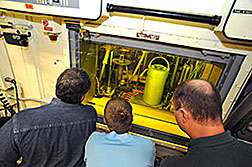A long journey toward advanced nuclear fuels

After years of waiting, a trans-Atlantic voyage and a cross-country trip, a cask containing four experimental irradiated pins of nuclear fuel arrived at DOE's Idaho National Laboratory in late July. The pins traveled from the Phénix fast reactor in France, where INL researchers had shipped them more than eight years ago. At the same time a parallel experiment was running here in the United States.
"These fuels are intended for use in a fast reactor, but we don't have a fast reactor available for testing in the U.S.," explained INL nuclear engineer Heather Chichester. "So we've been running experiments under modified conditions in ATR (INL's Advanced Test Reactor). We believe that the modifications we've made reproduce most of the important aspects of the environment inside a fast reactor, but we needed to confirm that."
Researchers hope the conditions experienced by these fuels in the French fast reactor will line up with the conditions created for the identical fuels tested in ATR. This would signify that the ATR experiments accurately recreate fast reactor fuel behavior. If so, INL researchers can continue to use ATR irradiation experiments to study new fuels.
The research collaboration between the U.S. DOE and the French Atomic Energy Commission (CEA) is an important part of INL's research for DOE's Fuel Cycle Research & Development program. Transmutation, the act of turning one thing into another, involves re-using certain components of used nuclear fuel. This maximizes the energy received from mined uranium. It also decreases the quantity of hazardous, extremely long-lived radionuclides destined for nuclear repositories.
"Most of what's left in used light water reactor fuel—the uranium-238, plutonium-239 and a few minor actinides—can be reused in a fast reactor," Chichester said. "This would use our uranium resources more efficiently and reduce the size and heat of the used fuel that has to be disposed." Once considered waste material, spent nuclear fuel from today's reactors may serve a new purpose, as researchers around the globe work to develop the fast reactor fuels of tomorrow.
Provided by Oak Ridge National Laboratory




















